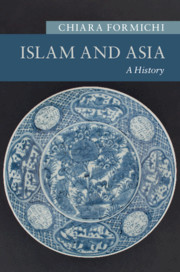Book contents
- Islam and Asia
- New Approaches to Asian History
- Islam and Asia
- Copyright page
- Dedication
- Contents
- Figures
- Maps
- Boxes
- Sources
- Preface
- Acknowledgments
- Note on Transliteration and Foreign Terms
- Maps
- Introduction
- 1 Islam across the Oxus (Seventh to Seventeenth Centuries)
- 2 Becoming Muslim (Seventh to Eighteenth Centuries)
- 3 Networks and Renewal (Thirteenth to Nineteenth Centuries)
- 4 Pan-Islamism and Nationalism (Nineteenth and Twentieth Centuries)
- 5 Muslims in the Nation-State (1940s to 1960s)
- 6 New Imaginations of Piety (1960s to 1990s)
- 7 Islam as Resistance
- 8 De-centering Islamic Authority
- 9 Studying Asia and Islam
- Glossary
- Notes
- Index
- New Approaches to Asian History
- References
2 - Becoming Muslim (Seventh to Eighteenth Centuries)
Published online by Cambridge University Press: 16 April 2020
- Islam and Asia
- New Approaches to Asian History
- Islam and Asia
- Copyright page
- Dedication
- Contents
- Figures
- Maps
- Boxes
- Sources
- Preface
- Acknowledgments
- Note on Transliteration and Foreign Terms
- Maps
- Introduction
- 1 Islam across the Oxus (Seventh to Seventeenth Centuries)
- 2 Becoming Muslim (Seventh to Eighteenth Centuries)
- 3 Networks and Renewal (Thirteenth to Nineteenth Centuries)
- 4 Pan-Islamism and Nationalism (Nineteenth and Twentieth Centuries)
- 5 Muslims in the Nation-State (1940s to 1960s)
- 6 New Imaginations of Piety (1960s to 1990s)
- 7 Islam as Resistance
- 8 De-centering Islamic Authority
- 9 Studying Asia and Islam
- Glossary
- Notes
- Index
- New Approaches to Asian History
- References
Summary
As the territory and influence of Muslim political authority expanded, the realities of Islamized societies varied greatly. While the resilient appeal of Arabia cannot be denied, the transformation of Asia led Muslims to give Islamic meaning to actions, beliefs, practices, and sensibilities that might have taken form along different paradigms from those emerged in Arabia. Through the centuries Muslims found alternative locations for pilgrimages to fulfill their ritual obligation, but also questioned Mecca’s status as an ideal embodiment of Islamicity as an imagined construct. The hajj rituals show borrowings from pre-Islamic practices, as does the architecture of “classic” mosques in North Africa and the Arab Mediterranean; in Mecca the fusion of local customs with “the law of Islam” was not different than in Java, Aceh, Malaya, or the Levant. Muslim places of worship, general sense of aesthetic, rituals, and legal interpretations adopted and adapted to what existed before the arrival of Islam, in Asia as much as in Arabia. This chapter provides empirical examples and theoretical frameworks to explore and articulate how processes of Islamization necessitated negotiations and active engagement between past and new traditions without undermining Muslims’ commitment to Islam’s precepts.
Keywords
- Type
- Chapter
- Information
- Islam and AsiaA History, pp. 42 - 74Publisher: Cambridge University PressPrint publication year: 2020

